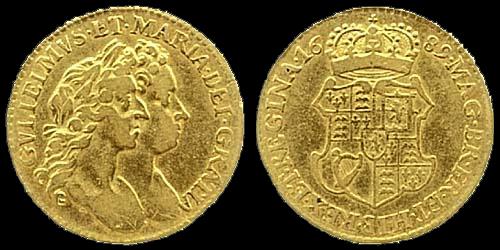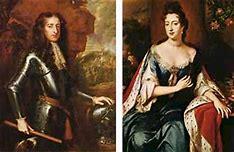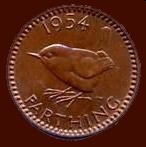








Designed by Nigel G Wilcox






The Paragon Of Metal Detecting
Powered By Sispro1
British Sterling Currency - Numismatics,
Half Guinea
For Reference ONLY
Everything For The Detectorist
Half Guinea
William & Mary 1689-1694 AD
Royal Monarchy
Copyright All Rights Reserved by Nigel G Wilcox E-Mail: ngwilcox100@gmail.com
INFORMATION - DATA
Pages

With the removal of James II in the Glorious Revolution of 1688, his daughter Mary, and her husband Prince William of Orange ruled jointly by agreement as co-monarchs. Their heads appear conjoined on the guinea piece in Roman style, with William's head uppermost, with the legend GVLIELMVS ET MARIA DEI GRATIA. In a departure from the previous reigns the reverse featured a totally new design of a large crowned shield which bore the arms of France in the first quarter, of Scotland in the second quarter, of Ireland in the third quarter, and of England in the fourth quarter, the whole ensemble having a small shield in the centre bearing the rampant lion of Nassau; the legend on the obverse read MAG BR FR ET HIB REX ET REGINA date.
By the early part of this reign the value of the guinea had increased to nearly thirty shillings. The half guineas of this reign weighed 4.2 grams, were 20 millimetres in diameter. The credit for the design of the gold coinage of this reign is usually given to James and Norbert Roettier, but the 1689 coin bears somewhat caricatured heads of the monarchs, and it is thought that this is in the style of George Bower (d. 1689/90), an artist who designed the first type of penny and halfpenny of 1689 and also produced a number of medals with grotesque and cartoon-like busts. Records show that Bower was instructed in July 1689 'to make a puncheon for the Halfe Guinneys ande to worke it in the Mint'; the heads of the halfpenny, penny, and half guinea of 1689 don't share the harmony of design of later Roettier work. Half guineas were produced in all years between 1689 and 1694 with the elephant and castle appearing in 1691 and 1692. A rare 1694 was estimated around 4,950.
Mary was the daughter of James II. For reasons of politics she had married William of Orange, James II nephew and left England to live with him in the Netherlands. When James II lost support, William was invited to invade England and to take over the throne jointly with his wife. James II escaped to France and lived there in exile until his death.
By the early part of this reign the value of the guinea had increased to nearly thirty shillings. The half guineas of this reign weighed 4.2 grams, were 20 millimetres in diameter. The credit for the design of the gold coinage of this reign is usually given to James and Norbert Roettier, but the 1689 coin bears somewhat caricatured heads of the monarchs, and it is thought that this is in the style of George Bower (d. 1689/90), an artist who designed the first type of penny and halfpenny of 1689 and also produced a number of medals with grotesque and cartoon-like busts. Records show that Bower was instructed in July 1689 'to make a puncheon for the Halfe Guinneys ande to worke it in the Mint'; the heads of the halfpenny, penny, and half guinea of 1689 don't share the harmony of design of later Roettier work. Half guineas were produced in all years between 1689 and 1694 with the elephant and castle appearing in 1691 and 1692. A rare 1694 was estimated around 4,950.
Mary was the daughter of James II. For reasons of politics she had married William of Orange, James II nephew and left England to live with him in the Netherlands. When James II lost support, William was invited to invade England and to take over the throne jointly with his wife. James II escaped to France and lived there in exile until his death.
William & Mary

Main Coin Menu

VIEW ALL MENUS
Member NCMD
6. S. Menu
























